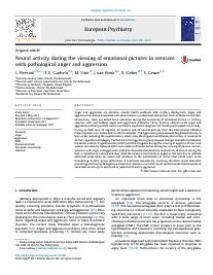Neural activity during the viewing of emotional pictures in veterans with pathological anger and aggression
Anger and aggression are common mental health problems after military deployment. Anger and aggression have been associated with abnormalities in subcortical and cortical levels of the brain and their connectivity.
Here, we tested brain activation during the processing of emotional stimuli in military veterans with and without anger and aggression problems.
Thirty military veterans with anger and aggression problems and 29 veterans without a psychiatric diagnosis (all males) participated in this study.
During an fMRI scan 32 negative, 32 positive and 32 neutral pictures from the International Affective Picture System were presented in intermixed order.
The Aggression group showed heightened activity in brain areas including the supplementary motor area, the cingulum and the parietal cortex, in response to stimuli, regardless of category.
Furthermore, the Aggression group showed stronger connectivity between the dorsal anterior cingulate cortex (dACC) and the amygdala during the viewing of negative stimuli, and weaker connectivity between dACC and medial prefrontal cortex during the viewing of positive stimuli.
Veterans with anger and aggression problems showed enhanced brain response to all stimuli during the task, irrespective of valence and they rated the pictures more likely as negative.
We take this to indicate enhanced preparation for action and attention to the presentation of stimuli that could prove to be threatening.
Further, group differences in functional connectivity involving the dACC reveal abnormal processing of stimuli with negative and positive valence. In sum, the results point towards a bias towards an enhanced sensitivity to perceived or potential threat in aggression.
Geachte bezoeker,
De informatie die u nu opvraagt, kan door psychotraumanet niet aan u worden getoond. Dit kan verschillende redenen hebben,
waarvan (bescherming van het) auteursrecht de meeste voorkomende is. Wanneer het mogelijk is om u door te verwijzen naar de bron
van deze informatie, dan ziet u hier onder een link naar die plek.
Als er geen link staat, kunt u contact opnemen met de bibliotheek,
die u verder op weg kan helpen.
Met vriendelijke groet,
Het psychotraumanet-team.
In: European Psychiatry, ISSN 0924-9338 | 47 | January | 1-8
http://dx.doi.org/10.1016/j.eurpsy.2017.09.002


